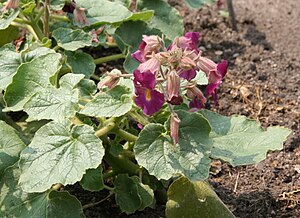Proboscidea fragrans
| Proboscidea fragrans | ||||||||||||
|---|---|---|---|---|---|---|---|---|---|---|---|---|

Proboscidea fragrans in flower. |
||||||||||||
| Systematics | ||||||||||||
|
||||||||||||
| Scientific name | ||||||||||||
| Proboscidea fragrans | ||||||||||||
| ( Lindl. ) Decne. |
Proboscidea fragrans is a species of the genus Proboscidea in the chamois horn family( Martyniaceae ). She comes from the new world .
description
Habitus
Proboscidea fragrans lives as an annual plant that arises from a strong beet root . The stem grows prostrate.
Vegetative characteristics
The mostly opposite leaves sit on stems up to 30 cm long. The lamina is broadly ovoid to kidney-shaped, the tip of the leaf is rounded to blunt, the base of the leaf is heart-shaped to blunt and sometimes uneven. The corrugated leaf margins are smooth to five-lobed and curved and wavy. The leaves and stems are hairy and sticky.
Generative characteristics
The very long stalked inflorescences are multi-flowered and tower above the foliage. There are bracts available. The flowers are fragrant, 30–40 appear per inflorescence. The flower stalks are each 1.8-4.0 cm long. The bracts are obovate to obovate, the calyx is 14–20 mm long, the sepals are mostly free-standing. The corolla is up to 4 cm long, it is pale to strong chestnut red, with yellow, orange or magenta-colored spots in the throat. It has yellow, abaxial nectar glands with dark purple spots on each adaxial lobe. The pedicels are hairy, the corolla and sepals are hairy on the outside. The flowering period abounds from May to November . The fruits are beaked with sloping meso-, exocarp , the woody endocarp , the capsule, is dark brown or dark gray, oblong-ellipsoid, slightly compressed and on one side with a crest. The "body" of the capsule is up to 8 cm long. The horns or hooks are up to 18 cm long. The seeds are dark gray to black, 7–9 mm long, 4–6 mm wide and rhomboid to ovate.
The number of chromosomes is 2n = 30.
distribution
Proboscidea fragrans is native to the southern states of the United States , especially Texas and New Mexico , and in Mexico it occurs. It was naturalized in Australia .
Systematics
Proboscidea fragrans has long been considered a subspecies of Proboscidea louisianica . More recent, phylogenetic studies, however, identify them as an independent species. Prob. fragrans from prob. louisianica due to the clearly darker flowers and the different leaf margins.
- Proboscidea fragrans ( (Lindl.) Decne. ); Toritos, Cuernito, Cuernitos de Buey; Syn. Proboscidea louisianica subsp. fragrans (Lindl.) Bretting , Martynia fragrans ( Lindl. ), Martynia violacea ( Engelm. ), Proboscidea violacea ( Engelm. ).
literature
- Raul Gutierrez: A Phylogenetic Study of the Plant Family Martyniaceae (Order Lamiales). Dissertation, Arizona State Univ., December 2011, online (PDF; 41.7 MB), at ASU Digital Repository.
Individual evidence
- ↑ a b c d e f Raul Gutierrez: A Phylogenetic Study of the Plant Family Martyniaceae (Order Lamiales). Pp. 153 f, 161.